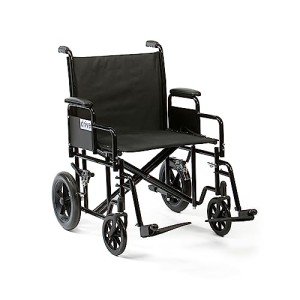A Glimpse In Bariatric Wheelchair 24 Inch Seat's Secrets Of Bariatric Wheelchair 24 Inch Seat

Bariatric Wheelchair Seat Width
Seat Width
Having the correct seat width is very important to wheelchair users who invest longer periods in their chairs. Too narrow a seat will cause pressure on the hips and thighs which might cause sores or pressure points. Having too wide a seat can likewise make it difficult for the user to reach the hand rims to propel themselves or maneuver in little spaces.
To measure the proper seat width an individual would rest on a chair usually and have their measurement taken throughout their lap at the largest point which is generally their hips. A wheelchair determining tape can be utilized to measure this, but a yard stick is preferred as it prevents individuals from covering the tape around their hips which would offer an incorrect result.

The basic wheelchair seat width is 16" (narrow grownup), 18" (basic adult), and 20" (broad adult). For bariatric clients, a 24" seat is offered. This heavy-duty extra broad bariatric wheelchair from Medline features swing-away footrests, a carbon steel frame with rust- and chip-resistant chrome plating, and easy-to-clean vinyl upholstery. It has a weight capacity of 500 pounds.
Seat Depth
Generally, the seat depth of a bariatric wheelchair was added 2" to the measurement taken at the user's widest point (typically their hips). This was indicated to accommodate extra layers of clothing that might be used throughout winter. However, bariatric wheelchair for sale is becoming less common as wheelchair users have the ability to spend more time indoors and are not using long coats. This makes the seat depth of a chair less important when choosing a bariatric wheelchair. However, it is still essential to choose a choice that uses adequate assistance for larger users.
The Medline folding extra large bariatric manual wheelchair includes a comfy 24" seat width and a heavy-duty slide tube silver vein frame. It likewise has an adjustable axle and tool-free raising legrests.
Seat Height
When it concerns figuring out the right wheelchair seat width you should constantly determine from the user's best point which is generally their hips. You will also need to consider whether the user is going to be using a winter coat as this may add 2" to the width needed.
When a wheelchair is in usage it ought to just be operated on level surface areas with the wheel locks totally engaged. This is to prevent the chair from having the ability to move slopes that are 10 degrees or greater. It is likewise crucial to remember that any activity that might move the center of mass in the chair ought to be done with care. This includes grabbing items that require the person to lean out of their seat or attempting to stand from it.
Whenever you have the chair in use it is advised that you regularly examine it for damage and oil any locations that are deemed needed. For instance, the casters need to be oiled by eliminating the caster fork and utilizing a multi-purpose grease to use to the caster stem bearings. Likewise, the foot plates can be changed by loosening up the bolt and after that moving them to the wanted position. This permits the feet to sit conveniently on the footplate and avoids any pressure points from forming. This can be really uncomfortable for the user and if left unattended, can cause push sores.
Weight Capacity
Bariatric wheelchairs are developed to support more weight than standard wheelchairs. This makes them tougher and better equipped to deal with falls. They are also generally bigger and broader, making them less maneuverable in tight spaces than basic wheelchairs. They need vehicles with unique ramps and lifts to fill them, along with motorists who know how to best transport them from one area to the next.
When choosing a wheelchair, consider its weight capacity as it will be the main determining consider whether it will accommodate your guest's needs. The weight capacity of the chair is typically listed as a fixed load, suggesting that it shows the amount of weight the chair can easily hold while standing still. However, some producers also note an active load that is based on a drop test and can mimic the impact of someone sitting down in the chair. This might be a more reliable measurement of the weight limit, depending upon your needs.
If you prepare to carry out activities that shift your center of mass in the seat (such as reaching for things), be sure to have front casters pointed in a forward direction and wheel locks engaged so the chair will not topple. Likewise, inspect that casters are oiled regularly to avoid extreme wear and abrasions. The lubrication procedure involves removing the fork, separating the caster from the wheel, and greasing the caster stem bearings with premium multi-purpose grease.
